- Green Enviro International Pvt Ltd
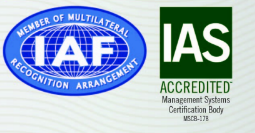



Fully Integrated Gaseous pollutant monitoring system with PM analyzer, High Performance Zero Air Generator, Dynamic Dilution Calibrator for online Calibration (EPA Designated).
PM Analyzer: Beta Ray Attenuation Technology for Measuring PM10 and PM2.5 by selecting corresponding cyclone cutter. For Range 0-1000 µg/m3 and 10000 µg/m3
SO2: UV Fluorescence Technology for range 0-2800 ppb with 0.5 Detectable limit. Additionally H2S will be measured with an internal catalytic converter
NOx(NO-NO2–NOx): Chemiluminescence Technology for range 0-2000 ppb with 0.5 Detectable limit. Additionally NH3 will be measured with an external converter
CO: NDIR Technology for range 0-100 ppm with 0.5 Detectable limit.
CO2: NDIR Technology for range 0-2000ppm with 0.5 Detectable limit
Ozone: UV Absorption Technology for range 0-1000 ppb with 0.5 Detectable limit.
Other gases on request
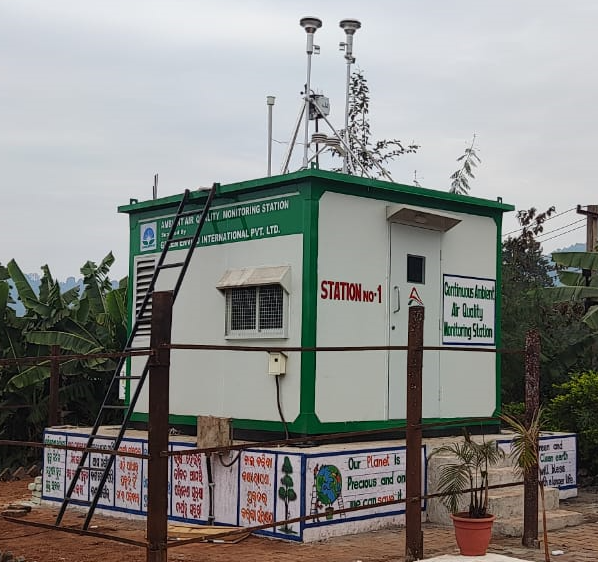
The AQMS-100 generates clean and dry zero air by removing components which will cause interference on monitoring results.
Regenerative scrubber The scrubber is filled with molecular sieve which has multiple holes and filters only water molecule with certain diameter. A second molecular sieve will be alternate for raw air diversion while the other is under regeneration by injecting compressed air to remove moisture.
HC/CO/NO scrubber To remove hydrocarbon, CO and NO, three dependent scrubbers applying catalytic reaction are used, where HC and CO will be converted into CO2 which does not interfere analysis and NO will be converted into NO2 which will then be removed by purifier.
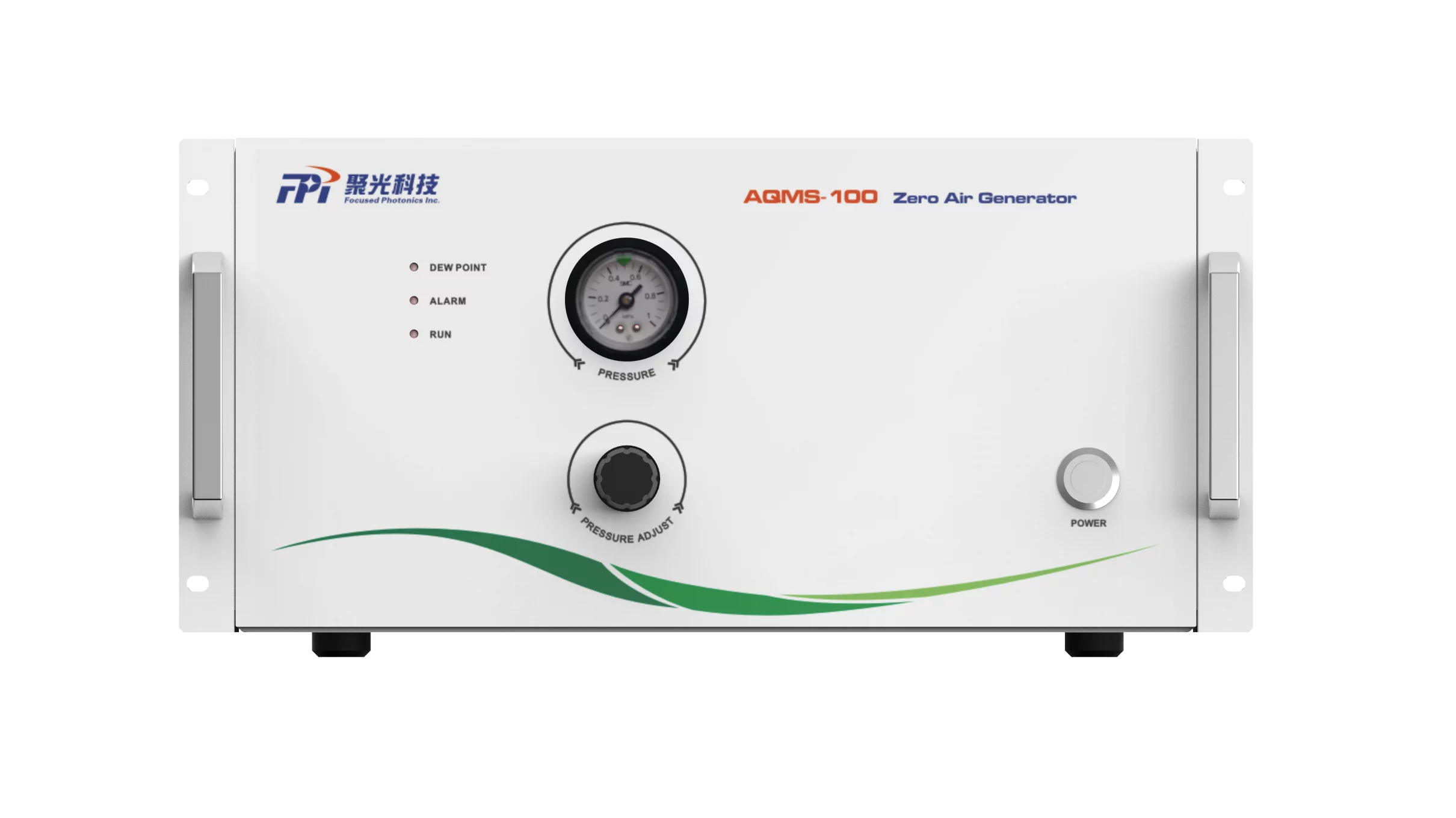
| Output | 20 SLPM at 30 psig |
| Dew Point | -30℃ |
| Output Concentration | SO2: < 0.025 ppb |
| NO: < 0.025 ppb | |
| NO2: < 0.025ppb | |
| O3: < 0.3 ppb | |
| CO: <10 ppb | |
| CH4: < 5 ppb | |
| Other HC: < 0.25ppb | |
| Power Requirement | 100~240 VAC, Converte applicable |
| Operating Temperature | 0~40℃ |
| Dimensions | 221mm(H) x 482mm(W) x 554(D) |
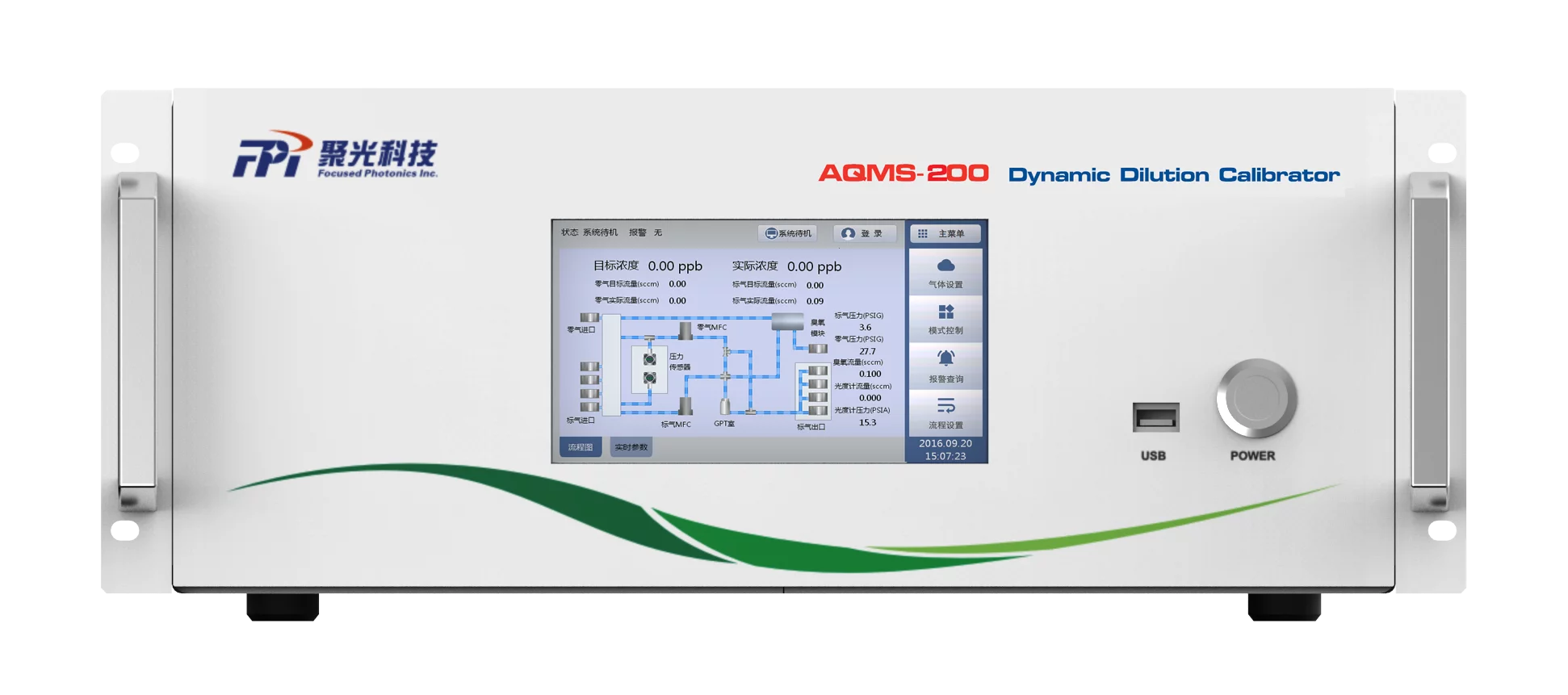
| Dilution System | Flow Measurement Accuracy | ± 1%F.S. |
| Repeatability | ± 0.2%F.S. | |
| Linearity | ± 0.5%F.S. | |
| Response Time | < 60s (T98) | |
| Flow Range of Dilution Air | 0~5 SLPM, 0~10 SLPM, 0~20 SLPM | |
| Flow Range of Cylinder Gases | 0~50 cc/min, 0~100 cc/min, 0~200 cc/min | |
| Calibration Gas Input Ports | 4 | |
| Diluent Gas Input Ports | 1 | |
| Ozone Generator(Optional) | Output | 0.1~6 ppm |
| Stability (7 days) | ± 1% | |
| UV Photometer(Optional) | Range | 0~100 ppb to 0~10 ppm (Selectable) |
| Precision | 1 ppb | |
| Linearity | ± 1%F.S. | |
| Rise/Fall Time | < 20s (photometer response) | |
| Response Time | < 180s (T98) | |
| Zero Drift (7 days) | 1 ppb | |
| Physical and Communication | Power Requirement | 100~240 VAC, 45~55 Hz |
| Dimensions and Weight | 178mm(H) x 432mm(W) x 604mm(D), 15kg | |
| Operating Temperature | 5~40°C | |
| Communication | RS232, RS485, Ethernet |
The concentration of ambient Ozone is proportional to UV Light Absorption since there is a significant characteristic absorption for Ozone on wavelength of 254nm.
Periodical diversion on sample flow passing through the ozone scrubber will generate reference measurement, which is compared with sample measurement to provide stable and representative result.
Ozone Scrubber The Ozone scrubber is filled with MnO as catalyst, which will convert O2 to O3 to form reference gas. Meanwhile, the presence of other components remains the same.
Data storage and analysis Stored data are easily retrievable through the serial or ethernet port via PC client software, allowing operators to perform predictive diagnostics and enhanced data analysis by tracking parameter trends.
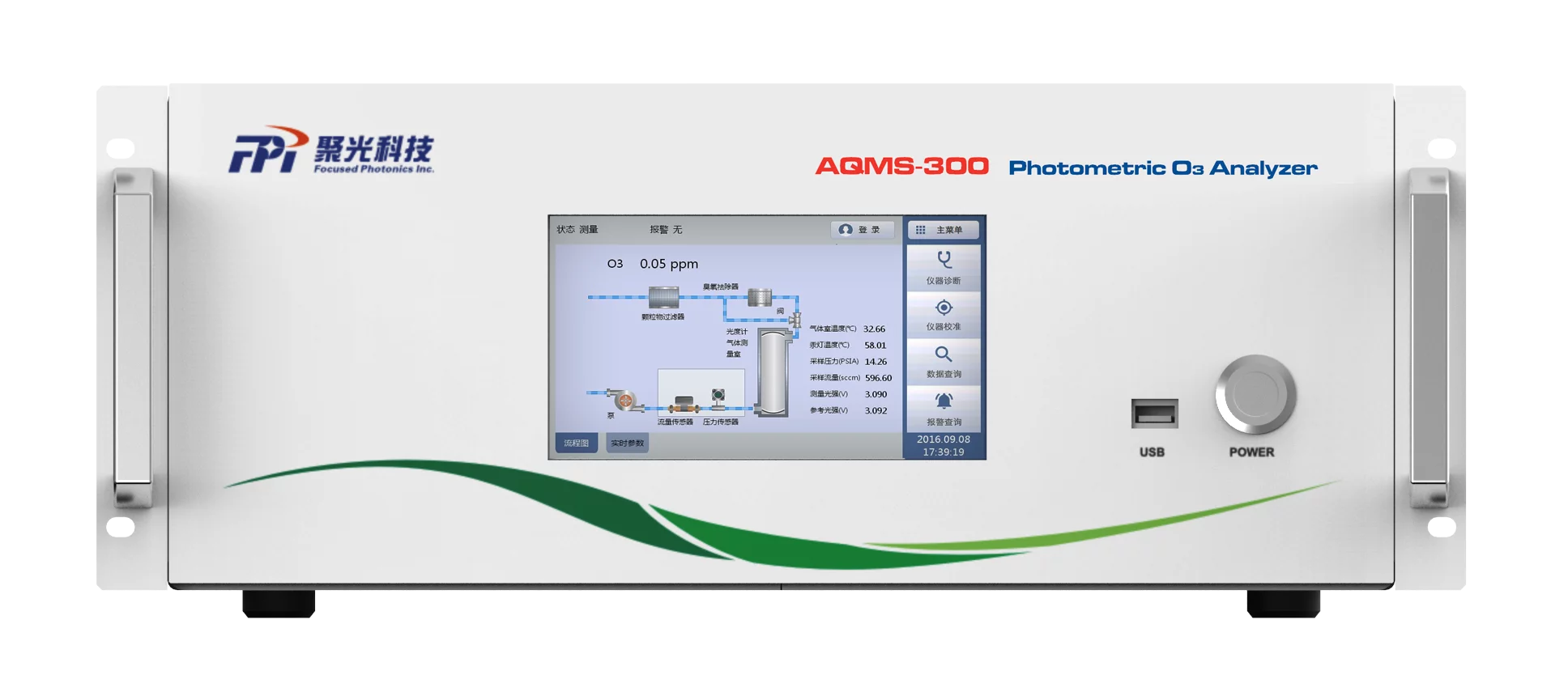
| Standard Range | Min: 0~100 ppb F.S. Max: 0~10 ppm F.S. (Selectable) |
| Zero Noise | < 0.3 ppb (RMS) |
| Span Noise | < 0.5% of reading (RMS) above 100 ppb |
| Lower Detectable limit | < 1 ppb |
| Zero Drift (24 hours) | < 1 ppb |
| Span Drift (24 hours) | < 1% F.S. |
| Response Time | < 20s (T90) |
| Precision | < 0.5% |
| Linearity | < 1% F.S. |
| Sample Flow Rate | 800 cc/min ±10% |
| Operating Temperature | 20~30°C range (per US EPA guidelines). Instrument maybe safely operated over the range of 5~40°C |
| Power Requirement | 100~240 VAC, Converter applicable |
| Dimensions and Weight | 178mm(H) x 432mm(W) x 609mm(D), 15kg |
Infrared energy emitted by light source is passed through gas chamber containing the air sample, and the quantitative absorption of energy by CO in the sample cell is measured by corresponding detector.
Data Storage and Analysis Stored data are easily retrievable through the serial or ethernet port via PC client software, allowing operators to perform predictive diagnostics and enhanced data analysis by tracking parameter trends.
GFC The Gas Filter Correlation (GFC) adopts Non-dispersive infrared technology and includes two units, one for reference and the other measurement.
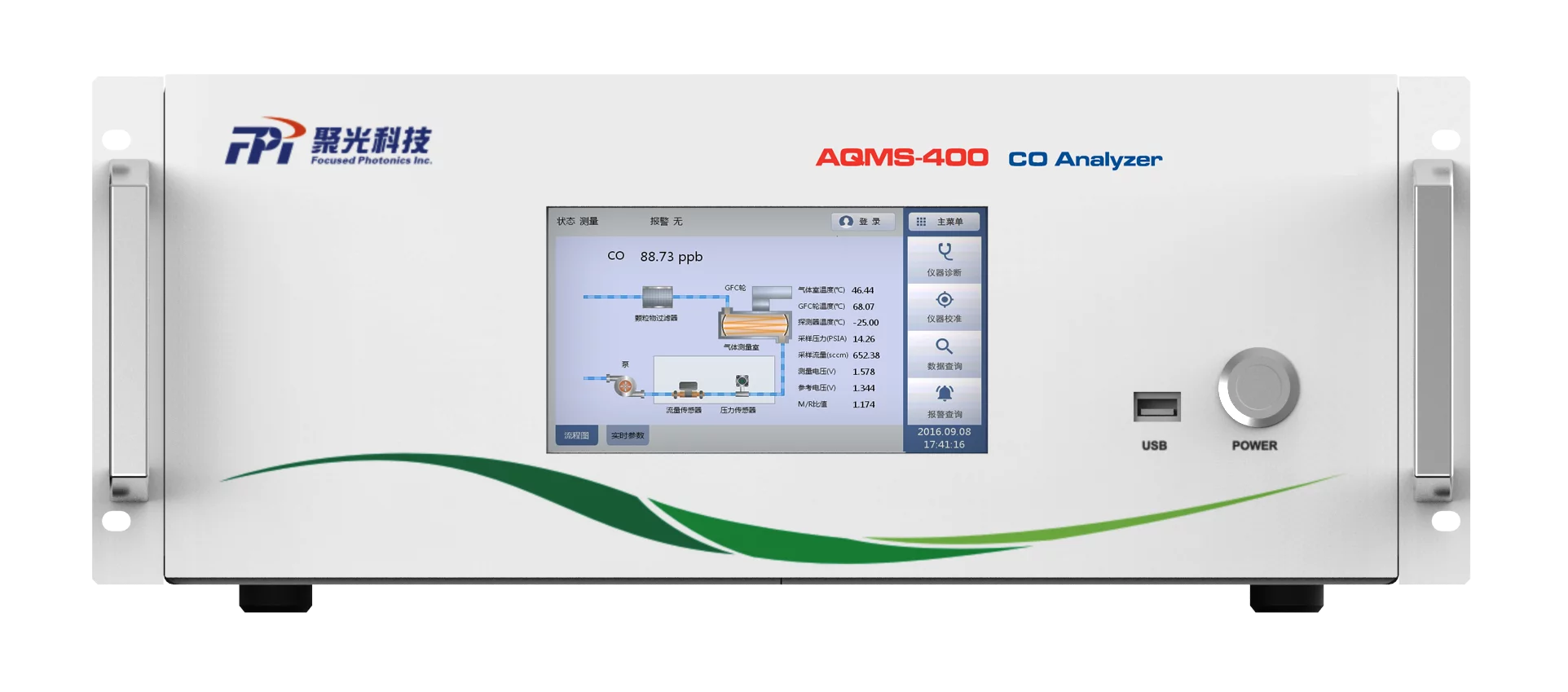
| US EPA Designation No. | RFCA–0419–252 |
| Standard Range | 0~1ppm to 1000ppm Selectable |
| Principle | NDIR |
| Zero Noise | ≤0.1ppm (RMS) |
| Span Noise | 0.5% F.S |
| Lower Detectable Limit | < 0.05ppm |
| Display | Digital |
| Zero Drift | < 0.1ppm/24h |
| Span Drift | < 1%F.S./24h |
| Linearity | < 1%F.S. |
| Precision | < 1% |
| Response Time | T90 < 60s |
| DSample Flow Rate | (800±80)sccm |
| I/O | 2 channel analog (4~20) mA; 2 analog (0~5) V; 1x Ethernet; 1x RS232; 1x RS485; 1x USB device ports; 6x Relay Output; 8x Status output port; 8x Control input port |
| Operating Temperature | US EPA Specification 20-30°C; Actual applicable: -5-55°C |
| Operating Humidity | 0~95%RH(No condensation) |
| Calibration | Multi-point calibrator |
| Power Requirement | (220±22)VAC,(50±1)HZ |
| Dimensions and Weight | 178(H) x 432(W) x 604(D)mm, 28kg |
Infrared energy emitted by light source is passed through gas chamber containing the air sample, and the quantitative absorption of energy by CO in the sample cell is measured by corresponding detector.
GFC GFC (Gas filter correlation) technology is utilized to remove interference caused by moisture and other backgrounds. Two gas filled chambers are mounted on a rotating disc, which pass through an IR beam alternately. The measure chamber is filled with nitrogen while the reference chamber is filled with high concentration CO. IR beam then passes through the sample gas cell. The difference in absorbance is measured and provides a direct output of the gas concentration.
Data storage and analysis Stored data are easily retrievable through the serial or ethernet port via PC client software, allowing operators to perform predictive diagnostics and enhanced data analysis by tracking parameter trends.
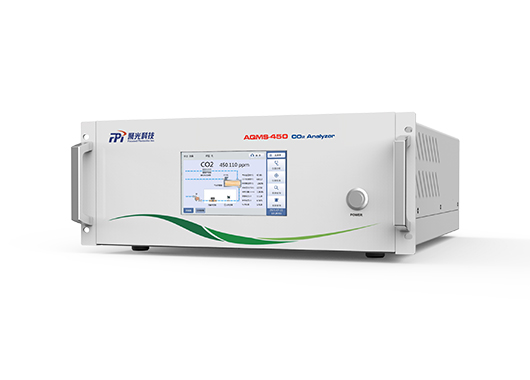
| Standard Range | 0~2000ppm |
| Zero Noise | ≤0.1ppm |
| Span Noise | ≤5ppm |
| Lower Detectable Limit | < 0.2ppm |
| Precision | ≤5ppm |
| Response Time | ≤90s (T90) |
| Output | 4~20mA, RS232, RS485, Ethernet |
AQMS-500 measures the intensity of the characteristic fluorescence released by SO2 in an ambient air sample contained in the gas chamber when the air sample is irradiated by ultraviolet light passed through the chamber.
UV Source The pulsing of the UV source lamp serves to increase the optical intensity whereby a greater UV energy throughput and lower detectable concentration are realized.
Data Storage and Analysis Stored data are easily retrievable through the serial or ethernet port via PC client software, allowing operators to perform predictive diagnostics and enhanced data analysis by tracking parameter trends.
Removal of Interferences The permeation scrubber acting as hydrocarbon kicker removes aromatic hydrocarbon such as xylene and naphthalene which causes interference. Optical filtering are employed to improve the rejection of interference from high nitrogen oxides.
PMT System The characteristic fluorescence of SO2 is received by the photomultiplier tube and converted into an electrical signal. The number of electrons is increased by the photomultiplier system and the current or voltage is collected by the anode.
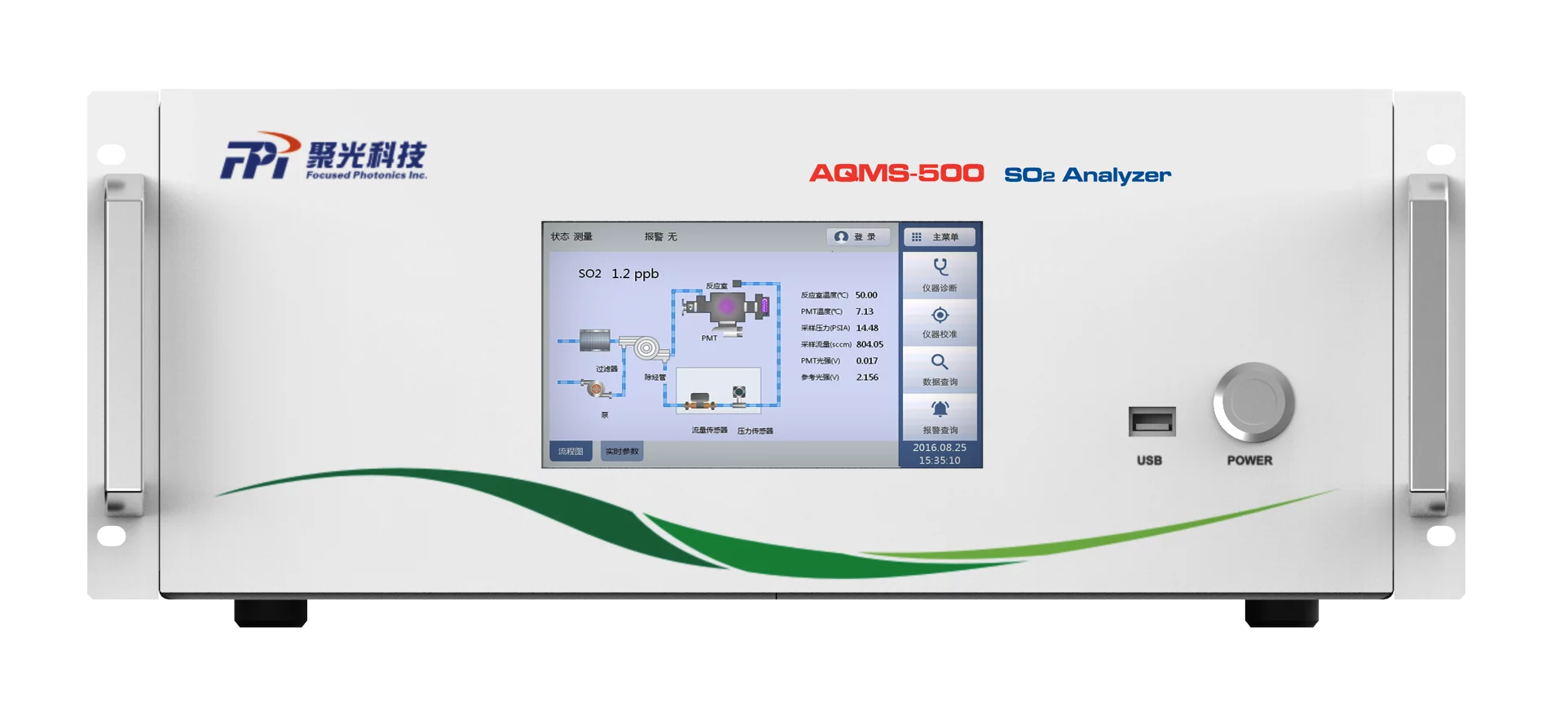
| US EPA Designation No. | RFSA–1219–255 |
| Standard Range | 0-1000ppb Selectable; 0-2000μg/m3(0-200,0-500, 0-1000, 0-2000μg/m3) |
| Principle | UV Fluorescence |
| Noise Level | 0.5ppb RMS (300 second averaging time) |
| Lower Detectable Limit | < 0.05ppb |
| Display | Digital |
| Zero Drift | < 0.1ppb/24h |
| Span Drift | < 1% |
| Linearity | < 1%F.S. |
| Precision | < 1% |
| Response Time | T90 < 60s |
| Sample Flow Rate | (650±65)sccm |
| I/O | 2 channel analog (4~20) mA; 2 analog (0~5) V; 1x Ethernet; 1x RS232; 1x RS485; 1x USB device ports; 6x Relay Output; 8x Status output port; 8x Control input port |
| Operating Temperature | US EPA Specification 20-30°C; Actual applicable: -5-55°C |
| Operating Humidity | 0~95%RH(No condensation) |
| Calibration | Multi-point calibrator |
| Power Requirement | (220±22)VAC,(50±1)HZ |
| Dimensions and Weight | 178(H) x 432(W) x 604(D)mm, 22kg |
AQMS-550 is equipped with an internally mounted catalytic converter set at 315°C to convert H2S to SO2. By passing the sample through a SO2 scrubber which removes any SO2, the H2S is converted to SO2 using this internal H2S converter and measured using the pulsed fluorescence technique.
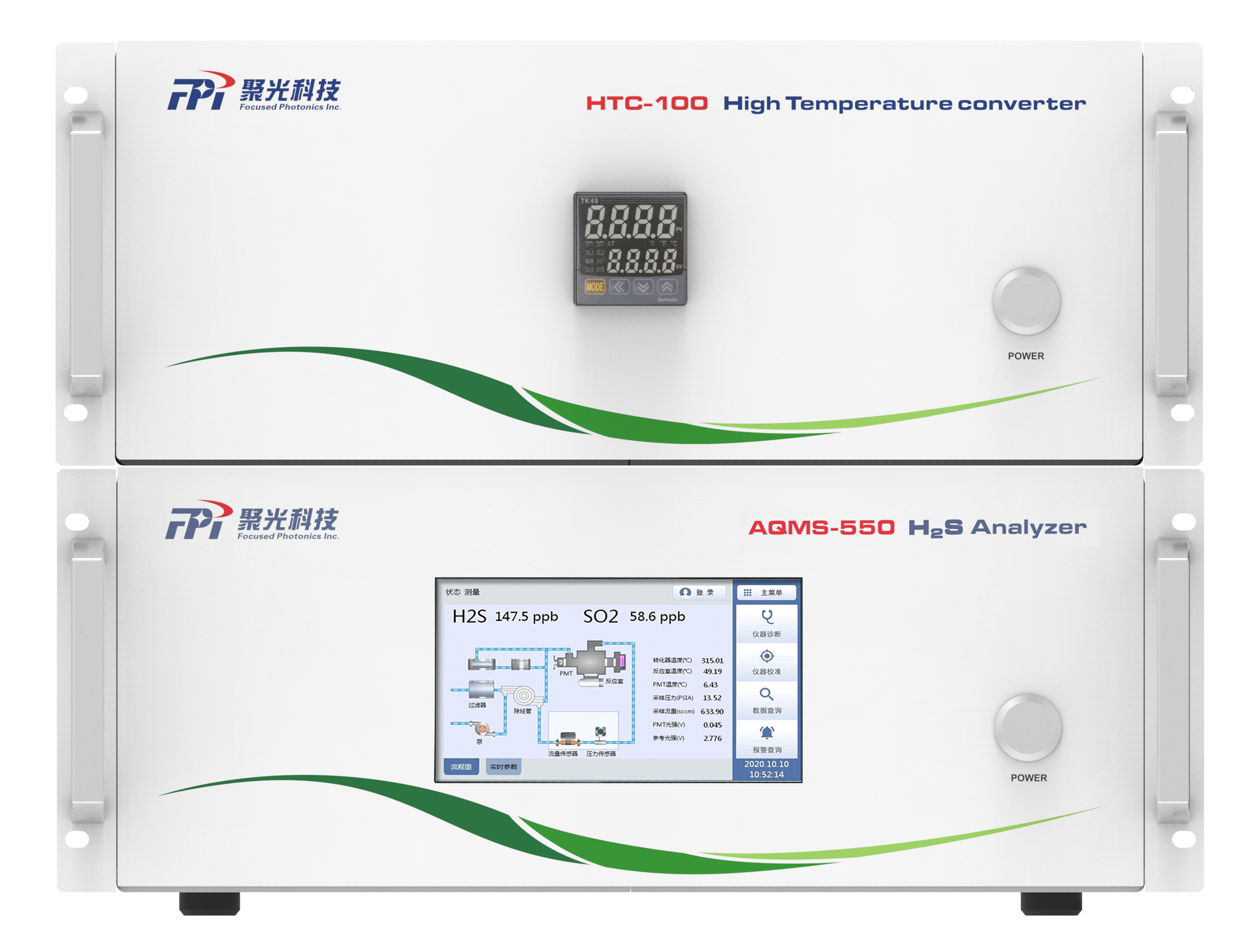
| Measured Gas | H2S in ambient |
| Standard Range | 0-1000ppb, 2000ppb |
| Principle | UV Fluorescence |
| Measurement Units | ppb, ppm, μg/m3, mg/m3 (selectable) |
| Lower Detectable Limit | < 0.4ppb or 0.5 % of reading |
| Zero Noise | < 0.2ppb (RMS) |
| Span Noise | < 1% F.S |
| Zero Drift | < 1ppb/24 hours;< 5ppb/7days; |
| Span Drift | < 1% F.S |
| H2S Converter | 315°C |
| Linearity | < 1%F.S. |
| Sample Flow Rate | ( 650±65)sccm |
| Response Time | T90 < 150s |
| Rise/Fall Time | < 30 second |
| Data Transmission | 2 channel analog (4~20) mA; 2 analog (0~5) V; 12 digital input/output; 4-way relay output; |
| Digital Output | 2 x RS232; RS485/Ethernet; |
| Operating Temperature | -5-55°C |
| Power Requirement | (230±10)VAC,(50±1)HZ |
| Dimensions | 178(H) x 432(W) x 604(D)mm |
| Weight | 18-19kg |
Nitrogen oxides in ambient are measured indirectly by photometrically measures the light intensity, resulting from the chemiluminescent reaction of Nitric Oxide (NO) with Ozone (O3). NO2 is first quantitatively reduced to NO by means of a converter. NO, which commonly exists in ambient air together with NO2, passes through the converter unchanged causing a resultant total NOX concentration equal to NO+NO2.
PMT The optical filter(660nm) attached on PMT provides reliable measurement, and temperature are controlled between 6~8℃ with only 0.1℃ fluctuation by a thermoelectric cooler, ensure the measurement stability.
Ozone generation Permeation dryer are introduced in ozone generation to provide long system durability without any replacement. An catalytic ozone scrubber is standard for maximum safety and pump life before exhaust.
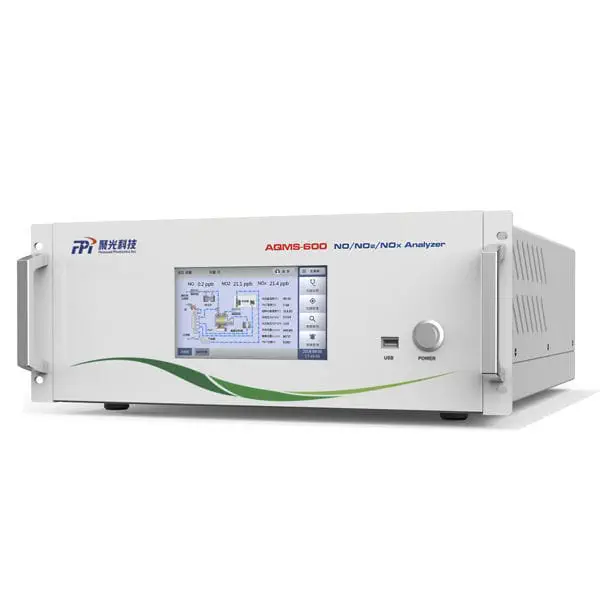
| US EPA Designation No. | RFNA–0819–254 |
| Principle | Chemiluminiscence |
| Standard Range | 0-1000ppb Selectable |
| Zero Noise | < 0.4 ppb (RMS) |
| Span Noise | < 0.5%(≥50ppb) |
| Display | Digital |
| Lower Detectable limit | 0.4ppb |
| Zero Drift (24 hours) | < 1 ppb |
| Span Drift (7 days) | < 1% FS |
| Response Time | < 100s (T90) |
| Precision | < 1% |
| Linearity | < 1% F.S. |
| Sample Flow Rate | ( 500±50)sccm |
| I/O | 2 channel analog (4~20) mA; 2 analog (0~5) V; 1x Ethernet; 1x RS232; 1x RS485; 1x USB device ports; 6x Relay Output; 8x Status output port; 8x Control input port |
| Calibration | Multi-point calibrator |
| Operating Temperature | US EPA Specification 20-30 °C; Actual applicable: -5-55°C |
| Operating Humidity | 0~95%RH(No condensation) |
| Power Requirement | (220±22)VAC, (50±1)HZ |
| Dimensions and Weight | 178mm(H) x 432mm(W) x 597mm(D), 22kg |
FPI AQMS-650 measures NH3 in the ambient air, which delivers a stable and precise value. It adopts Chemiluminescence Technology with an external converter which can combine its use with AQMS-600 measuring NOx as well; during the measurement, NH3 will be converted into NO by oxidation.
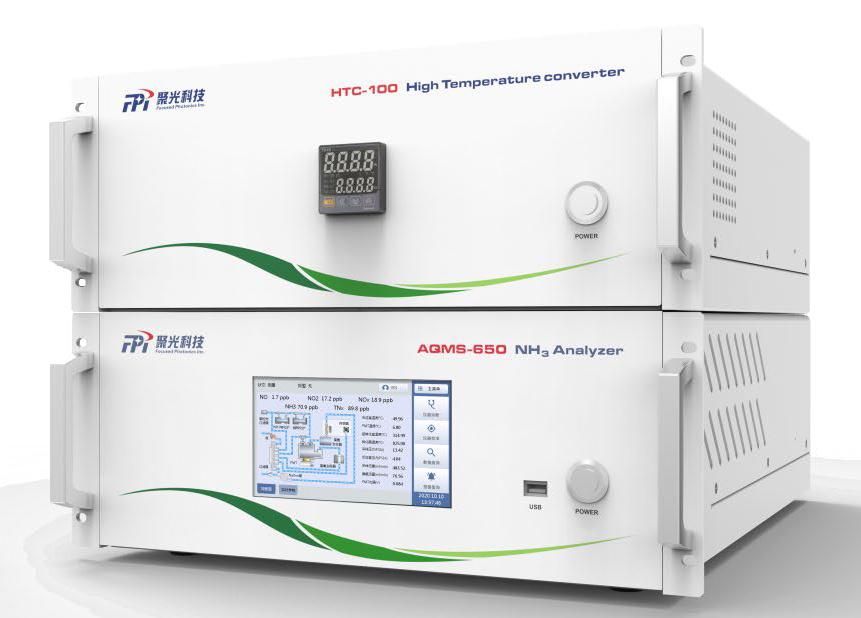
| Measured Gas | NH3 in ambient |
| Measured Units | ppb, ppm, μg/m3 , mg/m3 |
| Principle | Chemiluminiscence |
| Standard Range | 0-1000ppb |
| Lower Detectable Limit | < 0.4ppb or 0.5 % of reading |
| Zero Noise | < 0.2 ppb |
| Span Noise | < 0.2%F.S. |
| Zero Drift (24 hours) | < 1ppb/24hours; <5ppb/7days |
| Span Drift (7 days) | < 1% FS |
| NH3/NO Converter | Quartz at 10000 C |
| Sample Flow Rate | 1000cm /min ±10% |
| Response Time | < 300 second |
| Linearity | < 1% F.S. |
| Rise/Fall Time | < 30 second |
| Analog Output | 2 channel analog (4~20) mA; 2 analog (0~5) V; 12 digital output; 4-way relay output |
| Digital Output | 2 x RS232; RS485/Ethernet |
| Operating Temperature | -5-55°C |
| Power Requirement | (230±10)VAC,(50±10%)HZ |
| Dimensions and Weight | 178(H) x 432(W) x 604(D)mm Analyzer:20kg Converter:10-12Kg |
Particulate matter sample is pulled by a vacuum pump and concentrated on filter tape spot, the concentrated sample is advanced to measuring position where between beta ray source and detector. An attenuation signal of beta ray is detected which represents the mass of sample particulate. Particulate concentration can be determined by dividing mass to volume which has been strictly controlled during sampling with fixed flow rate.
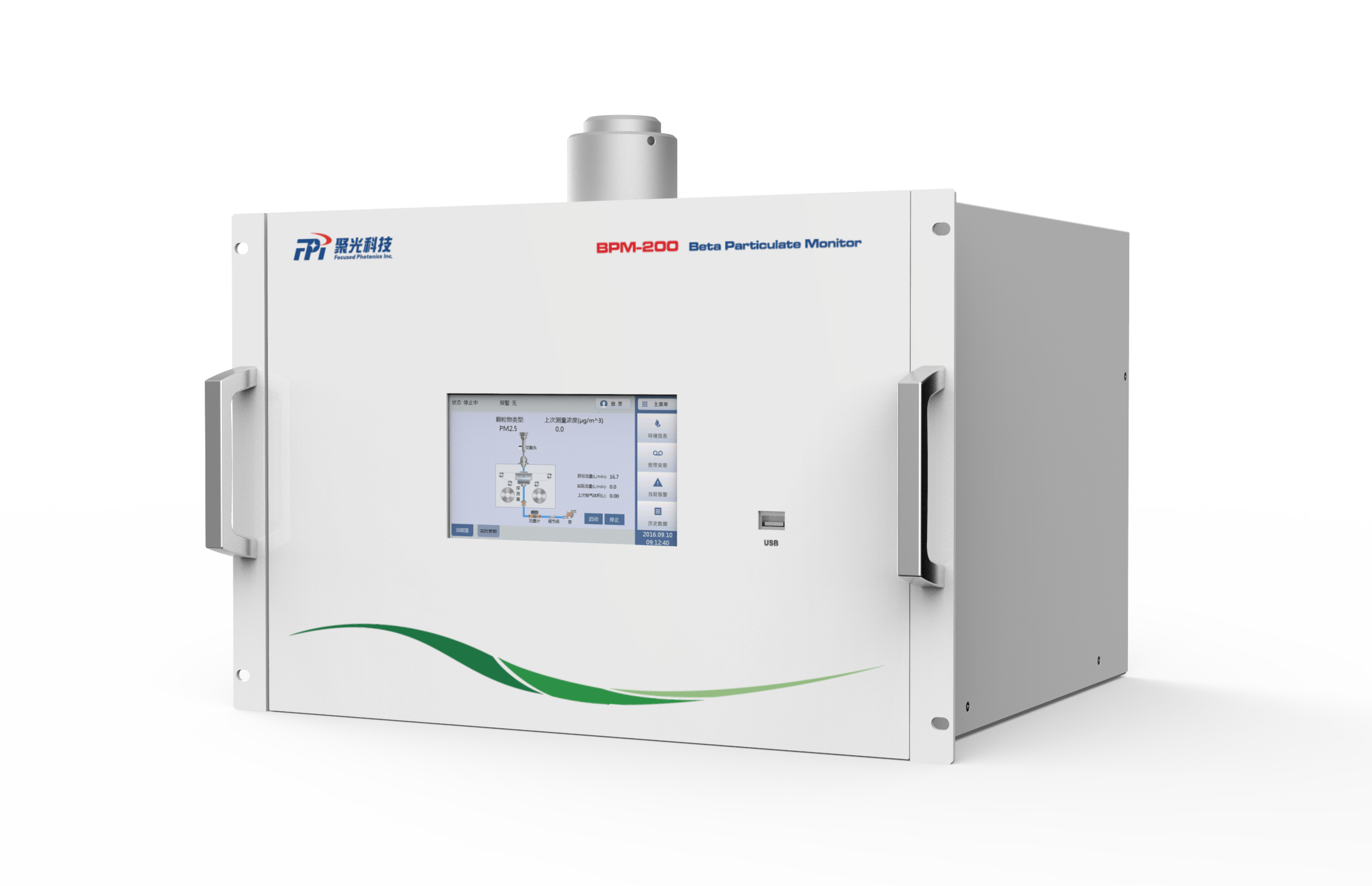
| US EPA Designation No. | EQPM-0121-258 |
| Principle | Beta ray attenuation |
| Resolution | 0.1μg/m3 |
| Lower Detectable Limit | 0.004mg/m3(PM10) 0.002 mg/m3(PM2.5) |
| Accuracy | ≤2% |
| Range | (0~1)mg/m3, (0~2)mg/m3, (0~5)mg/m3, (0~10)mg/m3(Selectable) |
| Sample Flow Rate | 16.7L/min |
| Display | LCD |
| Flow Accuracy | ±1%F.S |
| Flow Stability | ≤±2%/24h (Operation) |
| Calibration Film Reproducibility | ≤±2% |
| Sample Cycle | 60min (Optional ) |
| Source | C14 source, active10μCi, exemption source |
| Filter Paper Tape | Glass fiber |
| Roll Length | >20 meters |
| Detector | PMT |
| Communication | RS232/RS485/Ethernet; |
| Data Transmission | 2 analog (0~5) V; Data Transmission 2 channel analog (4~20) mA; 12 digital input/output; 4-way relay output; |
| Power Supply | (220±22)VAC, (50±1)HZ |
| Operating Temperature | (-5~55)°C |
| Ambient Humidity | 0~95%RH(No condensation) |
| Ambient Pressure | 86~116kPa |
| Dimensions | 310(H)x430(W)x400(D)mm |
| Weight | Round 25kg, without accessories |
Sample gas will be stored in the loop first, then realease them into PQ columns by switching the ten-way valve to the A state. Different components can be seperated in the PQ columes and transported to FID detector to measure respectly.
Full Heated Design The whole process heat tracing FID detection avoids high-boiling VOC attached, promoting the accuracy. No steam condensation, avoiding corrosion of components.
High Integration The FID flame will light automatically after warm-up time. It is continuous online analysis, automatic cycle operation at startup.
Automatic Operation Analysis cycle less than 10 minutes Operation continuously with free maintenance.
Measurement Range Hundreds of VOCs including total hydrocarbon, non-methane hydrocarbon, BTEX and ordour.
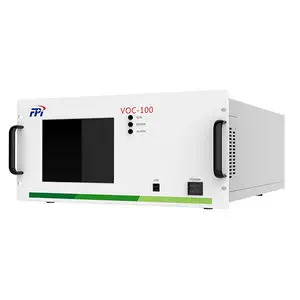
| Measurement Components | Methane NMHC THC |
| Principle | Flame Ionization Detector(FID) |
| Range | Methane: 0.1~1000ppm; NMHC: 0.05~100(or 1~10000ppm) |
| Detection Limit | 0.05ppm |
| Repeatability | RSD≤2% |
| Response Time | ≤60s |
| Gas Source Requirement | Carrier gas: high purity nitrogen or zero-level air; Gas Source Requirement Gas: high purity hydrogen; Combusion-supporting gas: zero-level air; |
| Digital Communication | 4~20mA, RS485, RS232, modbus |
| Power Supply | < 800 VA, 220V AC/50Hz |
| Condition Temperature | (5~35)°C |